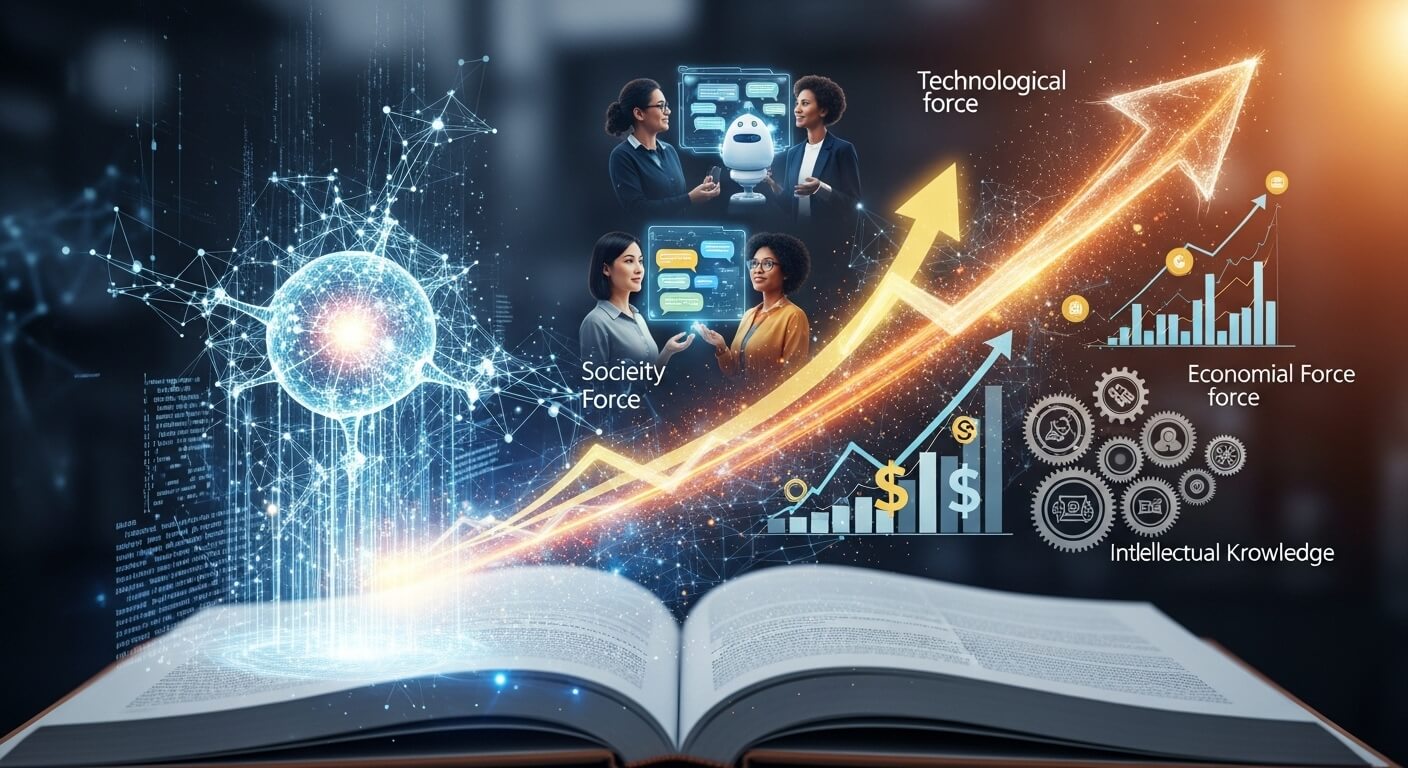Introduction: Decoding the Force Behind NLP AI’s Rapid Ascent
The rise of natural language-processing (NLP) AI tools has revolutionized how we interact with technology, from chatbots resolving customer queries to advanced systems like ChatGPT generating human-like text. But what broader force does this surge represent? In business and strategic analysis, the rise of NLP AI tools exemplifies a technological force, particularly within frameworks like PESTLE (Political, Economic, Social, Technological, Legal, Environmental) analysis. This force captures innovations that disrupt industries, reshape workflows, and drive economic shifts by enabling machines to understand and generate human language.
Technological forces are external factors arising from advancements in science and engineering that influence organizations and markets. The question “which type of force is exemplified by the rise of natural language-processing AI tools?” often surfaces in educational and business contexts, pointing to this category over social, political, or market forces. This article provides an in-depth exploration of NLP’s foundations, historical evolution, applications, and impacts, explaining why it embodies a technological force and its implications for businesses and society. Whether you’re a student, professional, or tech enthusiast, this guide offers clarity and actionable insights into this transformative development.
What is Natural Language Processing in AI?
Natural language processing is a branch of artificial intelligence that focuses on enabling computers to understand, interpret, and respond to human language in text or speech. It blends computational linguistics, machine learning, and deep learning to process unstructured data, such as emails, social media posts, or conversations.
Key NLP tasks include:
- Tokenization: Splitting text into words or phrases.
- Part-of-Speech Tagging: Identifying grammatical components like nouns or verbs.
- Named Entity Recognition (NER): Detecting names, locations, or organizations.
- Sentiment Analysis: Assessing emotions in text.
- Machine Translation: Converting languages, like Google Translate.
- Text Generation: Producing coherent content, as seen in advanced models like GPT.
Modern NLP relies on large language models (LLMs) trained on massive datasets, using neural networks to learn language patterns rather than relying on hardcoded rules. This adaptability has fueled its widespread adoption, positioning NLP as a cornerstone of digital transformation and a prime example of a technological force.
The History and Evolution of NLP AI
NLP’s journey began in the mid-20th century, evolving from theoretical ideas to practical tools. In 1950, Alan Turing’s Turing Test proposed evaluating machine intelligence based on human-like communication, setting the stage for NLP. Early efforts in the 1950s focused on machine translation, driven by geopolitical needs, with systems attempting to translate languages like Russian to English.
The 1960s and 1970s saw rule-based NLP systems, such as ELIZA, a 1966 chatbot mimicking a psychotherapist through pattern matching. Limited computing power and data stalled progress, leading to a slowdown known as the “AI winter.” The 1980s introduced statistical methods, using probability to improve accuracy. By the 1990s, machine learning enhanced NLP capabilities, laying groundwork for tools like early IBM Watson systems.
The 2010s marked a turning point with deep learning and big data. Word embeddings like Word2Vec (2013) enabled models to grasp semantic relationships. The introduction of transformer architectures, like Google’s BERT (2018) and OpenAI’s GPT series, revolutionized context understanding. The 2020s brought widespread accessibility through cloud computing, APIs, and open-source libraries, cementing NLP’s role as a technological force reshaping human-machine interactions.
The Rise of Modern NLP AI Tools
The last decade has seen an explosive rise in NLP AI tools, driven by advancements in hardware, algorithms, and data availability. In 2022, OpenAI’s ChatGPT gained millions of users by offering conversational AI capable of writing, coding, and answering queries. Google’s Bard and Meta’s language models have similarly enhanced search and social platforms.
Key drivers include:
- Data Growth: The internet provides vast text data for training.
- Computing Power: GPUs and TPUs support complex models.
- Open-Source Tools: Libraries like Hugging Face democratize NLP.
- Commercial Demand: Businesses invest heavily in AI automation.
This rise exemplifies a technological force by creating opportunities and challenges, pushing organizations to adapt or risk falling behind.
External Forces in Business Analysis: An Overview of PESTLE
To understand NLP’s classification, consider PESTLE analysis, a framework evaluating macro-environmental factors impacting organizations. It includes:
- Political: Government policies, regulations.
- Economic: Market conditions, financial trends.
- Social: Cultural shifts, demographics.
- Technological: Innovations, research advancements.
- Legal: Compliance, laws.
- Environmental: Sustainability, ecological concerns.
Technological forces involve emerging technologies that disrupt industries, such as AI’s integration into workflows. NLP’s growth fits squarely within this category, driven by scientific breakthroughs rather than social trends or market dynamics.
How the Rise of NLP Exemplifies Technological Force
The rise of NLP AI tools is a textbook example of a technological force, as it stems from innovations that redefine business and societal norms. Unlike social forces (e.g., changing consumer behaviors) or economic forces (e.g., market fluctuations), NLP’s development is rooted in advancements like transformer models, which have dramatically improved language processing.
This force compels industries to adapt. For example, NLP enables real-time translation in global trade, automates customer service, and enhances data analytics. In education, AI tutors personalize learning; in healthcare, NLP processes patient records for insights. Its technological nature lies in its independent evolution, though it influences other PESTLE factors, sparking legal debates on data privacy or economic shifts in job markets.
Impacts of NLP AI on Various Industries
NLP’s technological force has transformed multiple sectors:
- Healthcare: NLP analyzes medical notes for diagnostics and research, streamlining drug discovery.
- Finance: Sentiment analysis predicts market trends; chatbots reduce customer service costs.
- Retail: Recommendation systems personalize marketing; voice assistants enable shopping.
- Manufacturing: NLP processes maintenance logs for predictive analytics, reducing downtime.
- Education: Automated grading and virtual tutors enhance learning.
- Legal: AI tools accelerate contract analysis.
Estimates suggest generative AI, powered by NLP, could add trillions to global GDP annually. However, challenges like model biases and job displacement highlight the need for responsible adoption.
Case Studies: Real-World Examples of NLP’s Technological Impact
- ChatGPT: Transformed content creation, disrupting writing and coding professions.
- Google Translate: Evolved to neural-based translation, enabling global communication.
- Amazon’s Alexa: Uses NLP for smart home control, reshaping consumer tech.
- Customer Service AI: Regional tools enhance support, showing localized impact.
These examples illustrate how NLP drives innovation and competitive advantage.
Future Trends in NLP AI and Technological Forces
NLP is poised to integrate with multimodal AI, combining text, images, and video. Ethical AI, edge computing for privacy, and quantum computing advancements will shape its future. As a technological force, NLP could widen inequalities if unregulated but offers immense potential for accessibility and efficiency.
Frequently Asked Questions About NLP and Technological Forces
- What type of force does NLP AI represent in PESTLE analysis?
It exemplifies a technological force, driven by innovations in AI and computing that disrupt industries. - How does NLP AI differ from other external forces?
Unlike social (cultural trends) or economic (market dynamics) forces, NLP stems from scientific advancements, impacting other domains. - Why is NLP considered a technological force?
Its development through algorithms, data, and hardware advancements drives widespread industry changes. - What industries are most affected by NLP AI?
Healthcare, finance, retail, education, and legal sectors see significant efficiency and personalization gains. - Can NLP AI influence other PESTLE forces?
Yes, it sparks legal debates (e.g., data privacy), economic shifts (e.g., automation), and social changes (e.g., accessibility). - How does NLP AI impact jobs?
It automates tasks like writing or customer service but creates roles in AI development and ethics. - What technologies enable NLP’s rise?
Deep learning, transformers, GPUs, and big data are key enablers. - Is NLP AI a social or market force?
No, it’s technological, though it influences social behaviors and market trends. - How does NLP AI affect business strategy?
It pushes companies to adopt AI for efficiency, personalization, and competitive advantage. - What are the risks of NLP AI as a technological force?
Risks include biases, job displacement, and privacy concerns, requiring ethical oversight. - How does NLP AI drive economic value?
It boosts productivity, reduces costs, and creates new markets, potentially adding trillions to GDP. - What’s the future of NLP as a technological force?
Integration with multimodal AI and ethical frameworks will expand its impact while addressing challenges.
Conclusion: Harnessing the Technological Force of NLP
The rise of NLP AI tools embodies a technological force, driven by breakthroughs in AI, data, and computing that reshape industries and society. From healthcare to retail, its applications demonstrate transformative potential, compelling businesses to adapt. Understanding NLP’s role within PESTLE analysis highlights its broader implications, from economic growth to ethical challenges. By staying informed and leveraging these tools responsibly, individuals and organizations can harness this force for innovation and progress.

The editor of All-AI.Tools is a professional technology writer specializing in artificial intelligence and chatbot tools. With a strong focus on delivering clear, accurate, and up-to-date content, they provide readers with in-depth guides, expert insights, and practical information on the latest AI innovations. Committed to fostering understanding of fun AI tools and their real-world applications, the editor ensures that All-AI.Tools remains a reliable and authoritative resource for professionals, developers, and AI enthusiasts.



